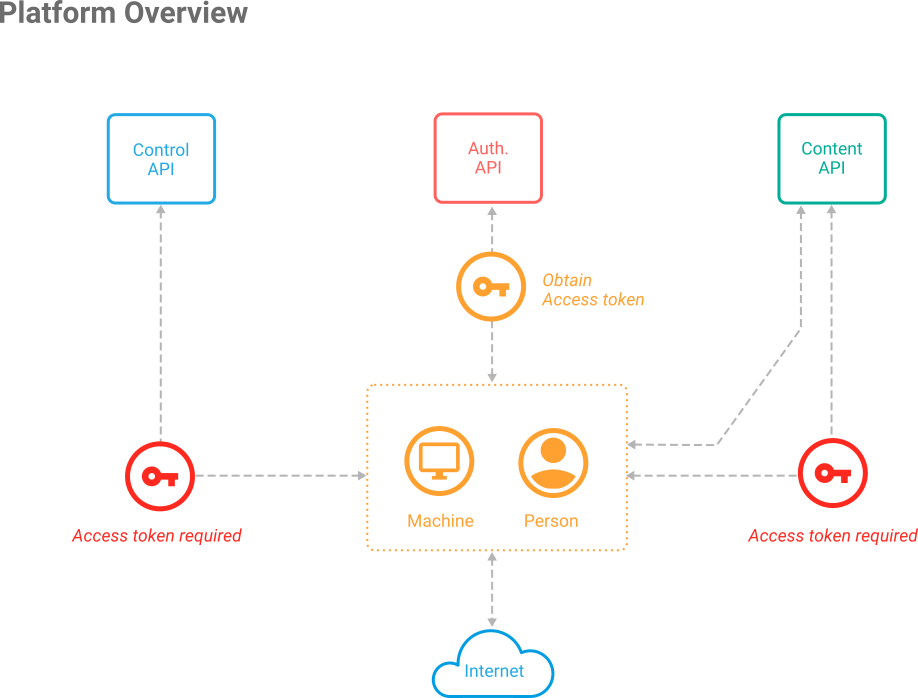Introduction¶
This is the place to start learning about the Crowdynews Web APIs. If you have any questions that you feel are unanswered here, hit us up on Twitter, or send an email to [email protected].
- About the Web APIs
- Authentication and Authorization
- Requests
- Responses
- Timestamps
- Response Status Codes
- Error Details

About the Web APIs¶
Your applications can interact with the Crowdynews platform
through the Crowdynews Web APIs. Unless specified otherwise,
you can access these APIs at https://api.crowdynews.com.
Authentication and Authorization¶
Unless specified otherwise, you'll require a valid OAuth
access token with correct permissions to access all endpoints.
Authentication and Authorization happens through the
Crowdynews Authorization API at https://auth.crowdynews.com.
For more information about authentication and authorization, see the Authorization Guide.
Requests¶
The Crowdynews Web APIs are based on REST principles: data resources are accessed via standard HTTPS requests in UTF-8 format to an API endpoint. Where possible, the API strives to use appropriate HTTP verbs for each action:
| VERB | DESCRIPTION |
|---|---|
| GET | Used for retrieving resources. |
| POST | Used for creating resources. |
| PUT | Used for replacing resources. |
| PATCH | Used for partially updating resources. |
| DELETE | Used for deleting resources. |
We try to comply to REST principles as much as possible.
Responses¶
All data is received as a JSON Object.
Resources¶
Every JSON resource Object contains at least the following fields:
| KEY | VALUE TYPE | VALUE DESCRIPTION |
|---|---|---|
| _id | String | A unique 24 character hexadecimal resource ID. |
| created | String | The timestamp that indicates when the resource was created. |
| createdBy | String | The consumer who created this resource. |
| lastModified | String | The timestamp that indicates when the resource was last modified. |
| lastModifiedBy | String | The consumer who last updated this resource. |
Resource IDs¶
These are unique, auto generated, 24 character, hexadecimal Strings.
Timestamps¶
Timestamps are returned in ISO 8601 format as Coordinated
Universal Time (UTC) with zero offset: YYYY-MM-DDTHH:MM:SSZ.
Response Status Codes¶
The API uses the following response status codes, as defined in the RFC 2616 and RFC 6585:
| STATUS CODE | DESCRIPTION |
|---|---|
| 200 | OK - The request has succeeded. The client can read the result of the request in the body and the headers of the response. |
| 201 | Created - The request has been fulfilled and resulted in a new resource being created. |
| 204 | No Content - The request has succeeded but returns no message body. |
| 304 | Not Modified. Appropriate cache-control headers are required to assist with client-side caching. |
| 400 | Bad Request - The request could not be understood by the server due to malformed syntax. |
| 401 | Unauthorized - The request requires authentication or, if the request included authentication credentials, authentication has been refused for those credentials. |
| 403 | Forbidden - The server understood the request, but is refusing to fulfill it. |
| 404 | Not Found - The requested resource could not be found. This error can be due to a temporary or permanent condition. |
| 500 | Internal Server Error - An unexpected condition was encountered and no more specific message is suitable. |
| 502 | Bad Gateway - The server was acting as a gateway or proxy and received an invalid response from the upstream server. |
| 503 | Service Unavailable - The server is currently unable to handle the request due to a temporary condition which will be alleviated after some delay. You can choose to resend the request again. |
All 4XX and 5XX reponse bodies contain more information
about the occurred error; see Error Details.
Error Details¶
Unsuccessful responses return information about the error as an error JSON Object containing the following information:
| PROPERTY NAME | VALUE TYPE | DESCRIPTION |
|---|---|---|
| requestId | String | Universally unique identifier for the request in question. |
| errors | Array | Contains one or more error objects. |
Error Object¶
An error object contains the following information:
| PROPERTY NAME | VALUE TYPE | DESCRIPTION |
|---|---|---|
| name | String | An error type descriptor. |
| message | String | A short description of the cause of the error. |
| propertyName | String | Optional. The name of the property the error applies to, if applicable. |
| propertyValue | String | Optional. The value of the property the error applies to, if applicable. |
| reason | String | Optional. Provides additional information about the error, if any. |
| code | Number | Optional. An application specific error code. |
Here's the error response you might see when an invalid email address is provided, when trying to create a resource:
HTTP/1.1 400 Bad Request
{
"requestId" : "b6e884e0-d4bc-11e5-a5c8-bf6ece15db6f",
"errors": [
{
"name": "ValidationError",
"message": "The provided email address is invalid.",
"propertyName": "email",
"propertyValue": "1234",
"reason": "regexp"
}
]
}